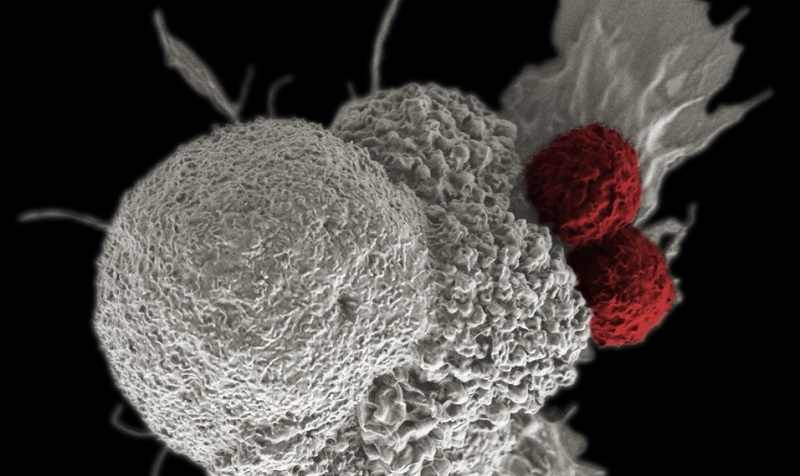Crowther and colleagues screened clones of T cells isolated from a healthy donor and identified a clone (MC.7.G5) that recognized and killed many different types of cancer cells, including cells from solid tumors. When mixed with lung, melanoma, leukemia, breast, colon, prostate, bone, or ovarian cancer cell lines, MC.7.G5 released tumor necrosis factor (TNF) and killed 80% or more of the cancer cells. This killing effect also occurred with primary cancer cells from ovarian cancer and melanoma, indicating that the recognition of the cancer cells was not related to long term culture of the cell lines.
Importantly, MC.7.G5 did not kill primary smooth muscle cells, hepatocytes, melanocytes from the skin, lung fibroblasts, or cells from intestine, kidney, or pancreas. This clone also did not kill T or B cells that had been activated or nontransformed cells that had been stressed or infected with Mycobacterium smegmatis.
Intriguingly, the T cell receptors (TCRs) on this clone recognized molecules presented by MR1 (MHC class 1-related protein), not MHC. The cells were αβTCR+γδTCR–CD8α+CD8βlowCD4–, consistent with their function as cytotoxic T cells.

Genome-wide CRISPR-Cas9 screening revealed that the cytotoxic effect of this clone depended on the genes encoding MR1 and β2m. This finding was confirmed by knocking out MR1 in cancer cells or adding an antibody that blocks MR1, both of which prevented the cytotoxic effect of MC.7.G5.
MR1-β2m complexes present antigens recognized by MR1-restricted T cells (MR1T cells) of which mucosal-associated invariant T (MAIT) cells are one type. Sequencing of the TCR-encoding genes revealed that these were not MAIT cells. Thus, MC.7.G5 represents a new type of T cell, a non-MAIT, MR1-restricted effector T cell with specificity toward cancer cells.
Whereas MHC presents peptides to T cells, MR1 complexes present metabolites. Most of the currently known molecules that interact with MR1 are microbial metabolites derived from either vitamin B2 or vitamin B9. However, some MR1T cells respond to uninfected cells, indicating that MR1 can present antigens that are not derived from microbial metabolism.
The molecules that cancer cells produce and that bind MR1 to induce the cytotoxic activity of MC.7.G5 cells could relate to the altered metabolism of cancer cells. These molecules await identification.
What makes the identification of MC.7.G5 (and another clone with cytotoxic activity toward multiple cancer cells from another donor) so exciting is that MR1 is encoded by a gene with limited variation. This contrasts with MHC-encoding genes, which are highly polymorphic. The TCRs from MC.7.G5 would recognize MR1 on cancer cells from different patients. Thus, these TCRs could potentially be used to engineer pan-cancer therapeutic immune cells for many patients.
Highlighted Article
M. D. Crowther, G. Dolton, M. Legut, et al. Genome-wide CRISPR-Cas9 screening reveals ubiquitous T cell cancer targeting via the monomorphic MHC class I-related protein MR1. Nature Immunology 21: 178–185 (2020) DOI:10.1038/s41590-019-0578-8
Watch on YouTube: [https://www.youtube.com/watch?v=YQnzhSsnnDU&feature=youtu.be]
Related Reading
H. E. McWilliam, J. A. Villadangos, MR1 antigen presentation to MAIT cells: new ligands, diverse pathways? Current Opinion Immunology 52: 108–113 (2018) DOI:10.1016/j.coi.2018.04.022
Harriff MJ, McMurtrey C, Froyd CA, et al. MR1 displays the microbial metabolome driving selective MR1-restricted T cell receptor usage. Science Immunology 3: eaao2556 (2018). DOI:10.1126/sciimmunol.aao2556
M. Lepore, A. Kalinichenko, S. Calogero, et al. Functionally diverse human T cells recognize non-microbial antigens presented by MR1 [published correction appears in Elife. 2017 Jun 20;6:]. Elife 6:e24476 (2017) DOI:10.7554/eLife.24476
M. G. Vander Heiden, R. J. DeBerardinis, Understanding the intersections between metabolism and cancer biology. Cell 168: 657–669 (2017) DOI:10.1016/j.cell.2016.12.039
N. R. Gough, Understanding How T Cell Receptors Recognize Proteins, Lipids, and Metabolites. Medium (27 February 2020) Full Text
Cite as: N. R. Gough, Discovery of a Pan-Cancer Killing T Cell. BioSerendipity (20 February 2020) https://www.bioserendipity.com/discovery-of-a-pan-cancer-killing-t-cell/

